JEEP RENEGADE 2018 Owner handbook (in English)
Manufacturer: JEEP, Model Year: 2018, Model line: RENEGADE, Model: JEEP RENEGADE 2018Pages: 356, PDF Size: 6.11 MB
Page 131 of 356
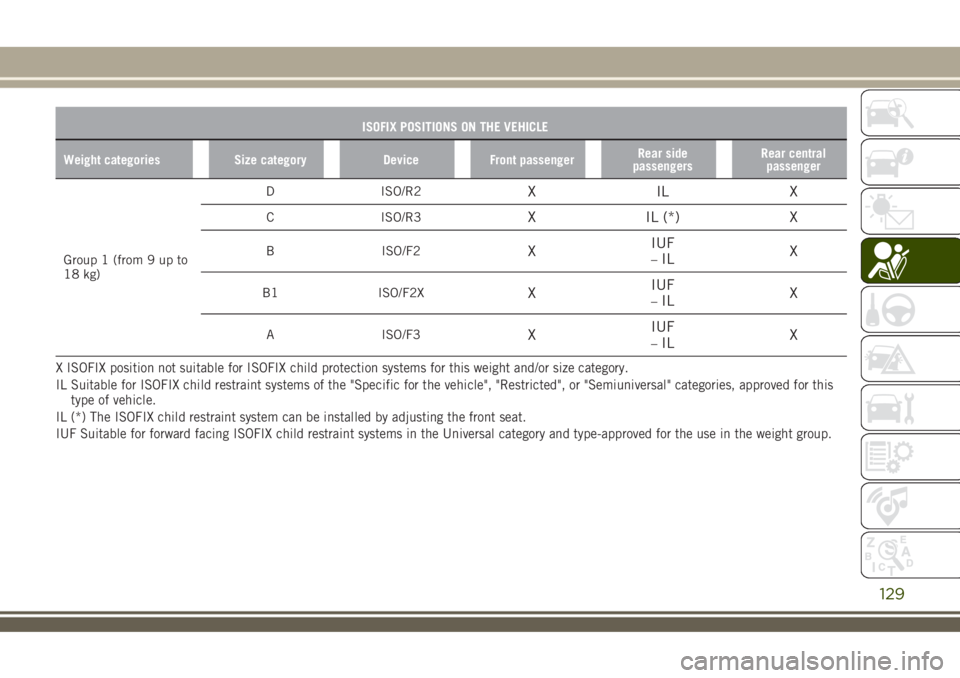
ISOFIX POSITIONS ON THE VEHICLE
Weight categories Size category Device Front passengerRear side
passengersRear central
passenger
Group 1 (from 9 up to
18 kg)D ISO/R2
XILX
C ISO/R3X IL (*) X
B ISO/F2XIUF–ILX
B1 ISO/F2XXIUF–ILX
A ISO/F3XIUF–ILX
X ISOFIX position not suitable for ISOFIX child protection systems for this weight and/or size category.
IL Suitable for ISOFIX child restraint systems of the "Specific for the vehicle", "Restricted", or "Semiuniversal" categories, approved for this
type of vehicle.
IL (*) The ISOFIX child restraint system can be installed by adjusting the front seat.
IUF Suitable for forward facing ISOFIX child restraint systems in the Universal category and type-approved for the use in the weight group.
129
Page 132 of 356
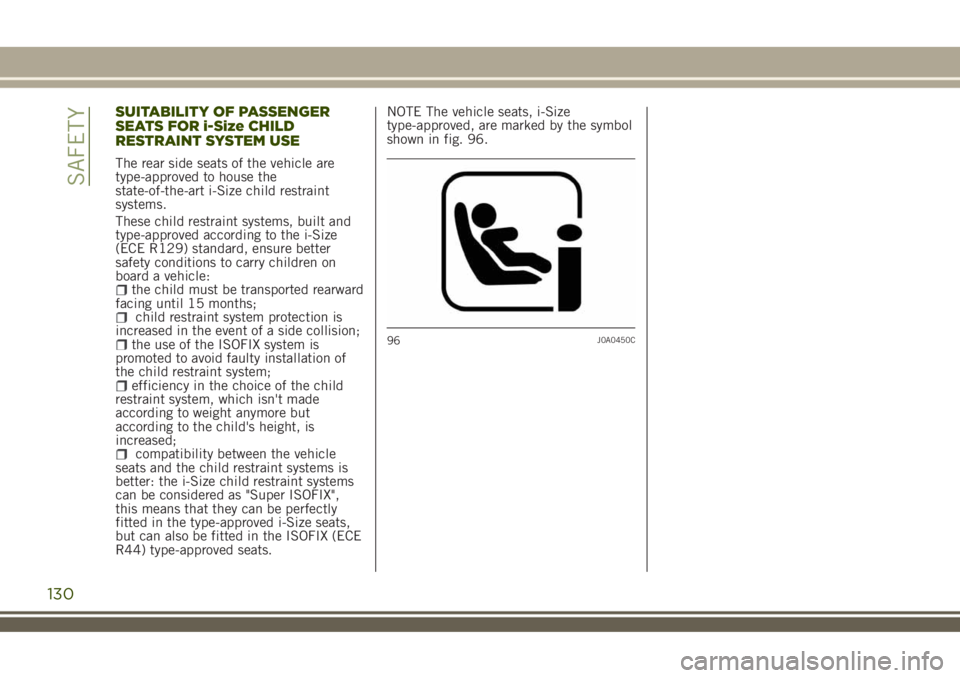
SUITABILITY OF PASSENGER
SEATS FOR i-Size CHILD
RESTRAINT SYSTEM USE
The rear side seats of the vehicle are
type-approved to house the
state-of-the-art i-Size child restraint
systems.
These child restraint systems, built and
type-approved according to the i-Size
(ECE R129) standard, ensure better
safety conditions to carry children on
board a vehicle:
the child must be transported rearward
facing until 15 months;
child restraint system protection is
increased in the event of a side collision;
the use of the ISOFIX system is
promoted to avoid faulty installation of
the child restraint system;
efficiency in the choice of the child
restraint system, which isn't made
according to weight anymore but
according to the child's height, is
increased;
compatibility between the vehicle
seats and the child restraint systems is
better: the i-Size child restraint systems
can be considered as "Super ISOFIX",
this means that they can be perfectly
fitted in the type-approved i-Size seats,
but can also be fitted in the ISOFIX (ECE
R44) type-approved seats.NOTE The vehicle seats, i-Size
type-approved, are marked by the symbol
shown in fig. 96.
96J0A0450C
130
SAFETY
Page 133 of 356
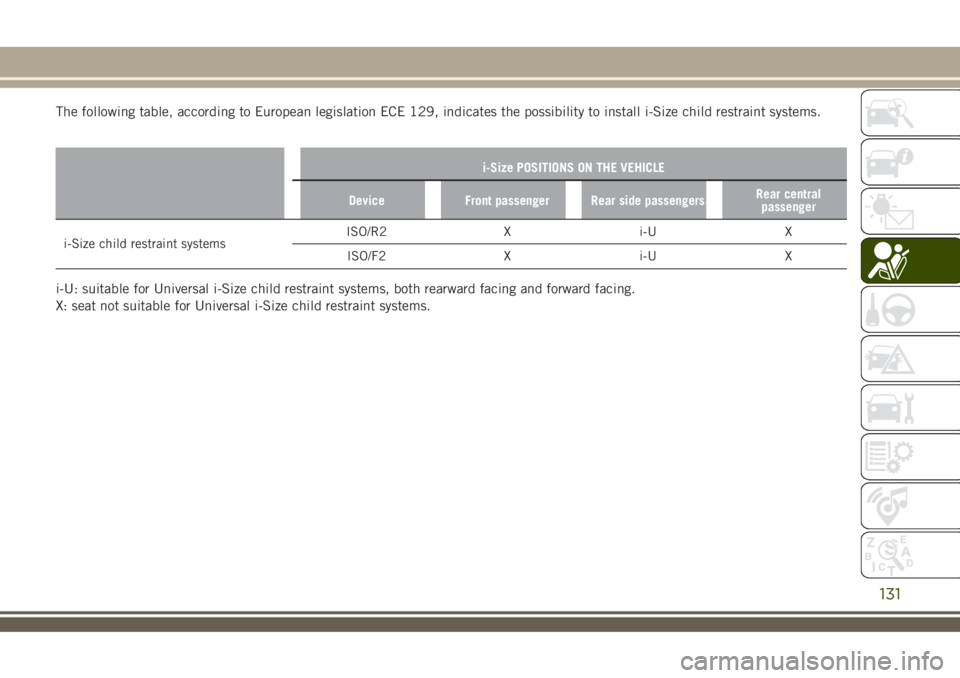
The following table, according to European legislation ECE 129, indicates the possibility to install i-Size child restraint systems.
i-Size POSITIONS ON THE VEHICLE
Device Front passenger Rear side passengersRear central
passenger
i-Size child restraint systemsISO/R2 X i-U X
ISO/F2 X i-U X
i-U: suitable for Universal i-Size child restraint systems, both rearward facing and forward facing.
X: seat not suitable for Universal i-Size child restraint systems.
131
Page 134 of 356
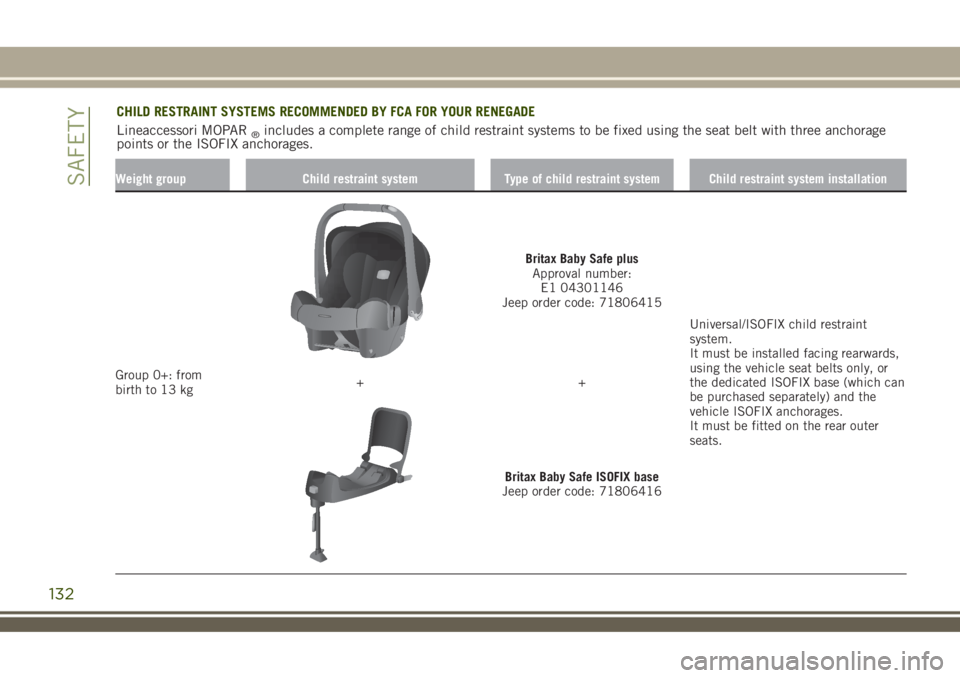
Weight group Child restraint system Type of child restraint system Child restraint system installation
Group 0+: from
birth to 13 kg
Britax Baby Safe plus
Approval number:
E1 04301146
Jeep order code: 71806415
Universal/ISOFIX child restraint
system.
It must be installed facing rearwards,
using the vehicle seat belts only, or
the dedicated ISOFIX base (which can
be purchased separately) and the
vehicle ISOFIX anchorages.
It must be fitted on the rear outer
seats. ++
Britax Baby Safe ISOFIX base
Jeep order code: 71806416
132
SAFETY
CHILD RESTRAINT SYSTEMS RECOMMENDED BY FCA FOR YOUR RENEGADE
Lineaccessori MOPAR
®includes a complete range of child restraint systems to be fixed using the seat belt with three anchorage
points or the ISOFIX anchorages.
Page 135 of 356
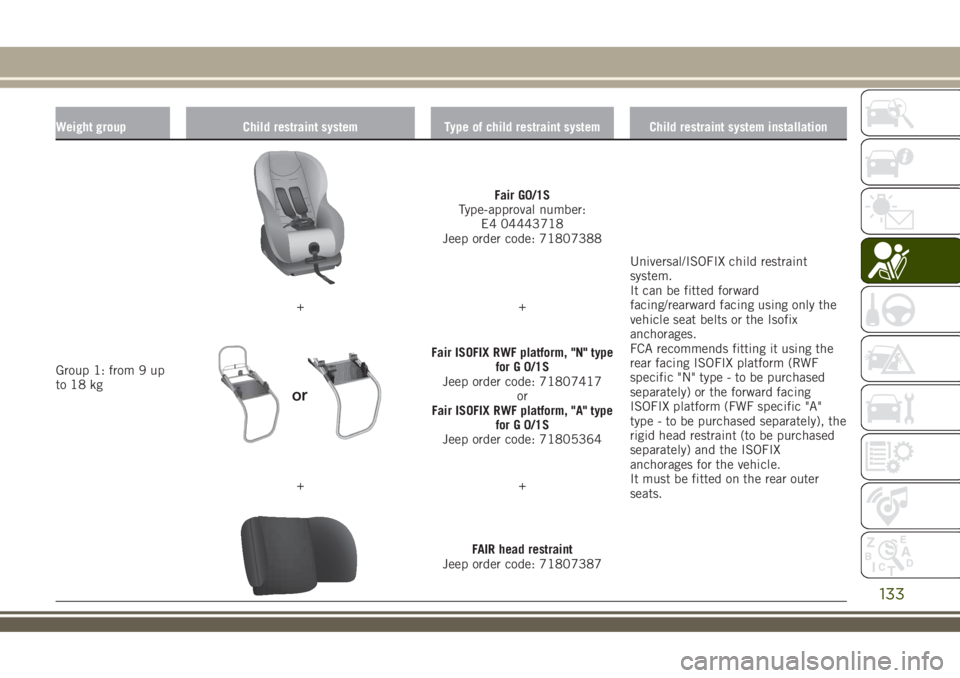
Weight group Child restraint system Type of child restraint system Child restraint system installation
Group 1: from 9 up
to 18 kg
Fair G0/1S
Type-approval number:
E4 04443718
Jeep order code: 71807388
Universal/ISOFIX child restraint
system.
It can be fitted forward
facing/rearward facing using only the
vehicle seat belts or the Isofix
anchorages.
FCA recommends fitting it using the
rear facing ISOFIX platform (RWF
specific "N" type - to be purchased
separately) or the forward facing
ISOFIX platform (FWF specific "A"
type - to be purchased separately), the
rigid head restraint (to be purchased
separately) and the ISOFIX
anchorages for the vehicle.
It must be fitted on the rear outer
seats. ++
Fair ISOFIX RWF platform, "N" type
for G 0/1S
Jeep order code: 71807417
or
Fair ISOFIX RWF platform, "A" type
for G 0/1S
Jeep order code: 71805364
++
FAIR head restraint
Jeep order code: 71807387
133
Page 136 of 356
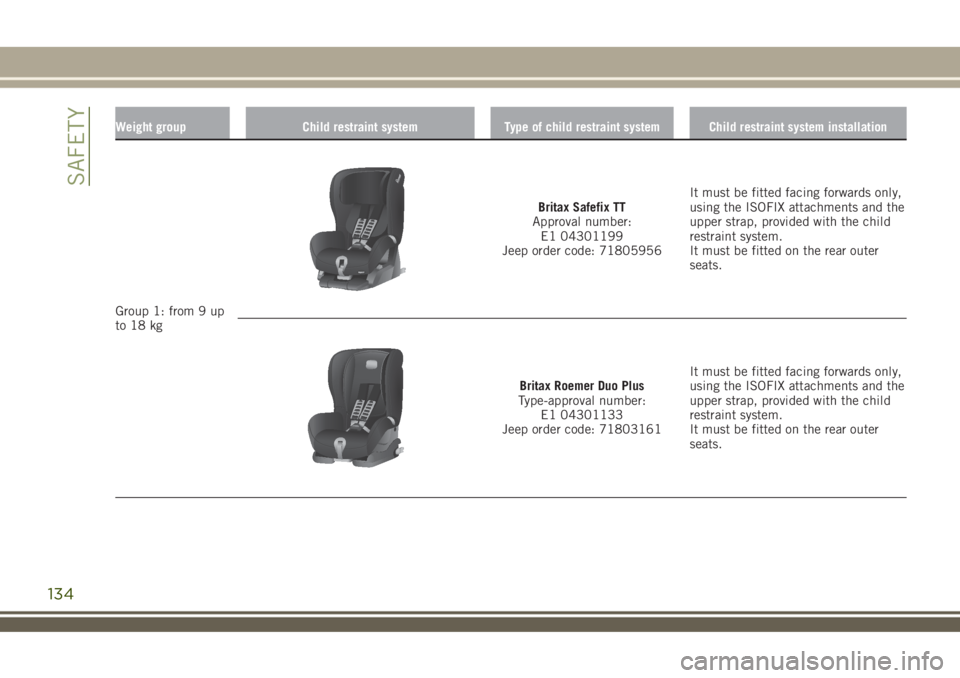
Weight group Child restraint system Type of child restraint system Child restraint system installation
Group 1: from 9 up
to 18 kg
Britax Safefix TT
Approval number:
E1 04301199
Jeep order code: 71805956It must be fitted facing forwards only,
using the ISOFIX attachments and the
upper strap, provided with the child
restraint system.
It must be fitted on the rear outer
seats.
Britax Roemer Duo Plus
Type-approval number:
E1 04301133
Jeep order code: 71803161It must be fitted facing forwards only,
using the ISOFIX attachments and the
upper strap, provided with the child
restraint system.
It must be fitted on the rear outer
seats.
134
SAFETY
Page 137 of 356
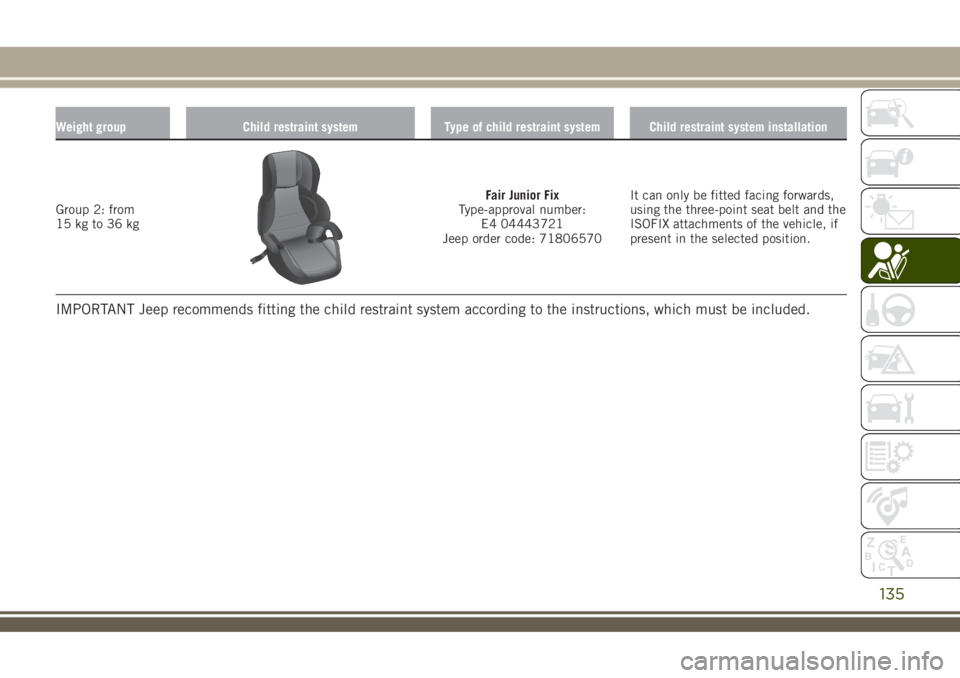
Weight group Child restraint system Type of child restraint system Child restraint system installation
Group 2: from
15 kg to 36 kgFair Junior Fix
Type-approval number:
E4 04443721
Jeep order code: 71806570It can only be fitted facing forwards,
using the three-point seat belt and the
ISOFIX attachments of the vehicle, if
present in the selected position.
IMPORTANT Jeep recommends fitting the child restraint system according to the instructions, which must be included.
135
Page 138 of 356
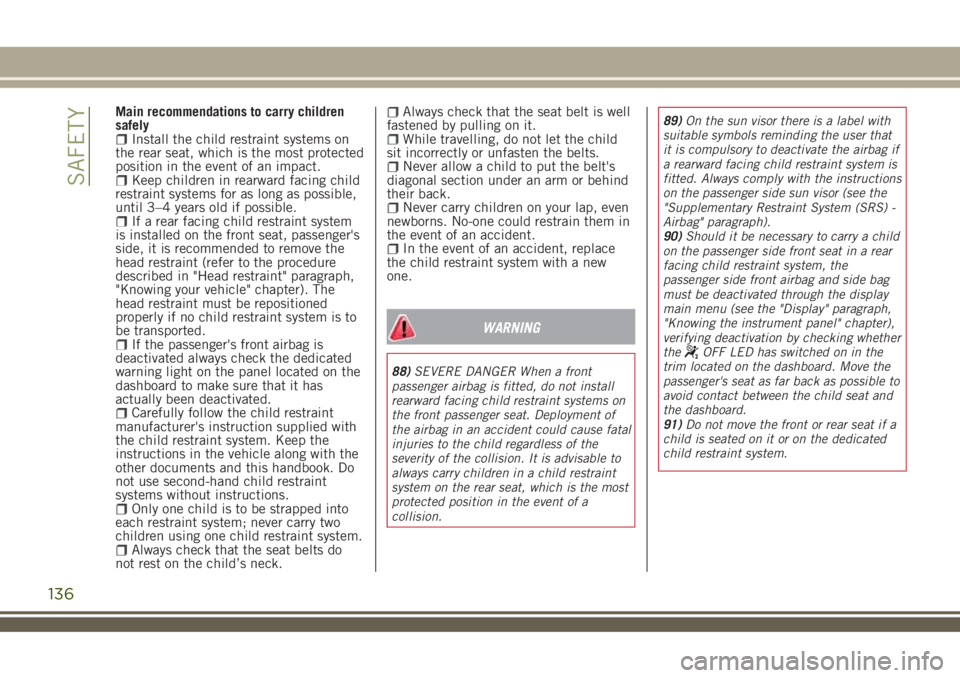
Main recommendations to carry children
safely
Install the child restraint systems on
the rear seat, which is the most protected
position in the event of an impact.
Keep children in rearward facing child
restraint systems for as long as possible,
until 3–4 years old if possible.
If a rear facing child restraint system
is installed on the front seat, passenger's
side, it is recommended to remove the
head restraint (refer to the procedure
described in "Head restraint" paragraph,
"Knowing your vehicle" chapter). The
head restraint must be repositioned
properly if no child restraint system is to
be transported.
If the passenger's front airbag is
deactivated always check the dedicated
warning light on the panel located on the
dashboard to make sure that it has
actually been deactivated.
Carefully follow the child restraint
manufacturer's instruction supplied with
the child restraint system. Keep the
instructions in the vehicle along with the
other documents and this handbook. Do
not use second-hand child restraint
systems without instructions.
Only one child is to be strapped into
each restraint system; never carry two
children using one child restraint system.
Always check that the seat belts do
not rest on the child’s neck.
Always check that the seat belt is well
fastened by pulling on it.
While travelling, do not let the child
sit incorrectly or unfasten the belts.
Never allow a child to put the belt's
diagonal section under an arm or behind
their back.
Never carry children on your lap, even
newborns. No-one could restrain them in
the event of an accident.
In the event of an accident, replace
the child restraint system with a new
one.
WARNING
88)SEVERE DANGER When a front
passenger airbag is fitted, do not install
rearward facing child restraint systems on
the front passenger seat. Deployment of
the airbag in an accident could cause fatal
injuries to the child regardless of the
severity of the collision. It is advisable to
always carry children in a child restraint
system on the rear seat, which is the most
protected position in the event of a
collision.89)On the sun visor there is a label with
suitable symbols reminding the user that
it is compulsory to deactivate the airbag if
a rearward facing child restraint system is
fitted. Always comply with the instructions
on the passenger side sun visor (see the
"Supplementary Restraint System (SRS) -
Airbag" paragraph).
90)Should it be necessary to carry a child
on the passenger side front seat in a rear
facing child restraint system, the
passenger side front airbag and side bag
must be deactivated through the display
main menu (see the "Display" paragraph,
"Knowing the instrument panel" chapter),
verifying deactivation by checking whether
the
OFF LED has switched on in the
trim located on the dashboard. Move the
passenger's seat as far back as possible to
avoid contact between the child seat and
the dashboard.
91)Do not move the front or rear seat if a
child is seated on it or on the dedicated
child restraint system.
136
SAFETY
Page 139 of 356
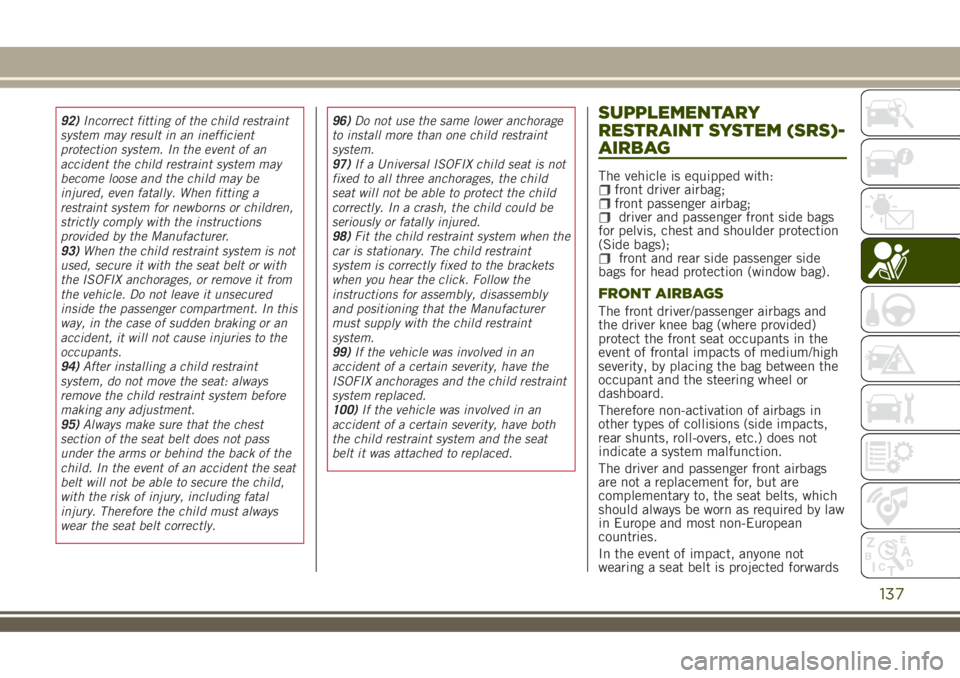
92)Incorrect fitting of the child restraint
system may result in an inefficient
protection system. In the event of an
accident the child restraint system may
become loose and the child may be
injured, even fatally. When fitting a
restraint system for newborns or children,
strictly comply with the instructions
provided by the Manufacturer.
93)When the child restraint system is not
used, secure it with the seat belt or with
the ISOFIX anchorages, or remove it from
the vehicle. Do not leave it unsecured
inside the passenger compartment. In this
way, in the case of sudden braking or an
accident, it will not cause injuries to the
occupants.
94)After installing a child restraint
system, do not move the seat: always
remove the child restraint system before
making any adjustment.
95)Always make sure that the chest
section of the seat belt does not pass
under the arms or behind the back of the
child. In the event of an accident the seat
belt will not be able to secure the child,
with the risk of injury, including fatal
injury. Therefore the child must always
wear the seat belt correctly.96)Do not use the same lower anchorage
to install more than one child restraint
system.
97)If a Universal ISOFIX child seat is not
fixed to all three anchorages, the child
seat will not be able to protect the child
correctly. In a crash, the child could be
seriously or fatally injured.
98)Fit the child restraint system when the
car is stationary. The child restraint
system is correctly fixed to the brackets
when you hear the click. Follow the
instructions for assembly, disassembly
and positioning that the Manufacturer
must supply with the child restraint
system.
99)If the vehicle was involved in an
accident of a certain severity, have the
ISOFIX anchorages and the child restraint
system replaced.
100)If the vehicle was involved in an
accident of a certain severity, have both
the child restraint system and the seat
belt it was attached to replaced.SUPPLEMENTARY
RESTRAINT SYSTEM (SRS)-
AIRBAG
The vehicle is equipped with:front driver airbag;front passenger airbag;driver and passenger front side bags
for pelvis, chest and shoulder protection
(Side bags);
front and rear side passenger side
bags for head protection (window bag).
FRONT AIRBAGS
The front driver/passenger airbags and
the driver knee bag (where provided)
protect the front seat occupants in the
event of frontal impacts of medium/high
severity, by placing the bag between the
occupant and the steering wheel or
dashboard.
Therefore non-activation of airbags in
other types of collisions (side impacts,
rear shunts, roll-overs, etc.) does not
indicate a system malfunction.
The driver and passenger front airbags
are not a replacement for, but are
complementary to, the seat belts, which
should always be worn as required by law
in Europe and most non-European
countries.
In the event of impact, anyone not
wearing a seat belt is projected forwards
137
Page 140 of 356
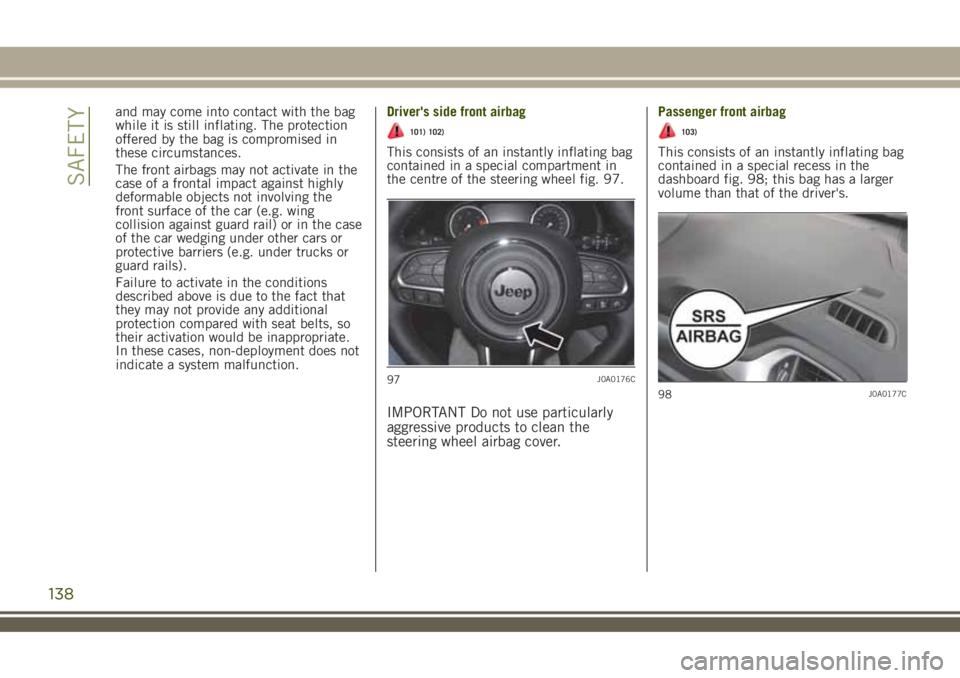
and may come into contact with the bag
while it is still inflating. The protection
offered by the bag is compromised in
these circumstances.
The front airbags may not activate in the
case of a frontal impact against highly
deformable objects not involving the
front surface of the car (e.g. wing
collision against guard rail) or in the case
of the car wedging under other cars or
protective barriers (e.g. under trucks or
guard rails).
Failure to activate in the conditions
described above is due to the fact that
they may not provide any additional
protection compared with seat belts, so
their activation would be inappropriate.
In these cases, non-deployment does not
indicate a system malfunction.Driver's side front airbag
101) 102)
This consists of an instantly inflating bag
contained in a special compartment in
the centre of the steering wheel fig. 97.
IMPORTANT Do not use particularly
aggressive products to clean the
steering wheel airbag cover.
Passenger front airbag
103)
This consists of an instantly inflating bag
contained in a special recess in the
dashboard fig. 98; this bag has a larger
volume than that of the driver's.
97J0A0176C
98J0A0177C
138
SAFETY